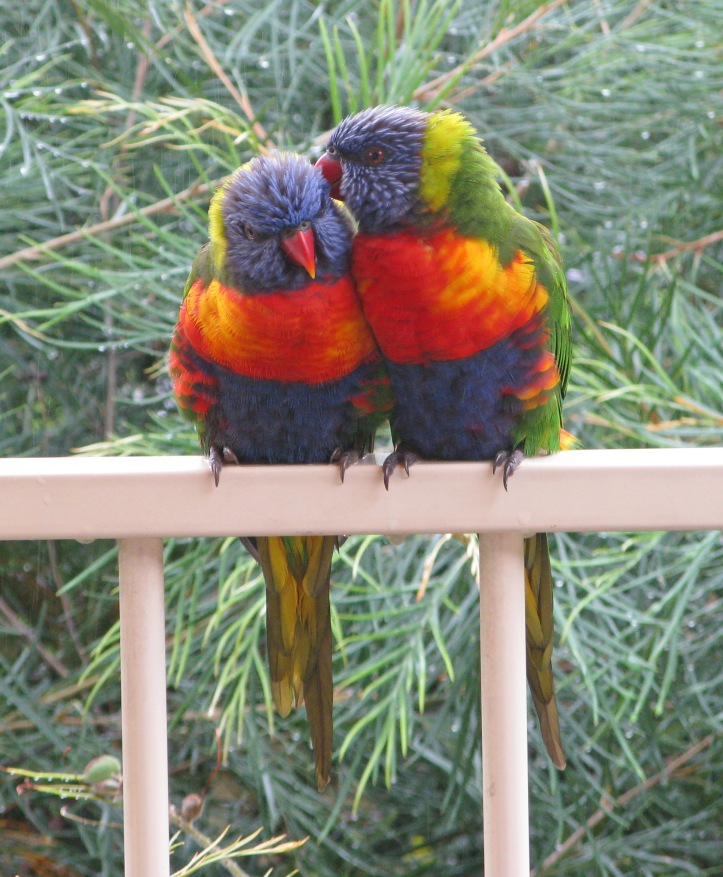When we moved into this house in 1998 we were delighted with the number of native birds that used to come visiting. A number of different Rosella, King Parrots, kookaburra and Galahs to name a few but the cheekiest was the colourful and cute Rainbow Lorikeet. They were quite tame. They would descend in flocks when the Grevillea and bottlebrush were in flower and when it rained they would take shelter on our front deck. (Both these photos were taken a few years ago.)
They were quite tame. They would descend in flocks when the Grevillea and bottlebrush were in flower and when it rained they would take shelter on our front deck. (Both these photos were taken a few years ago.) I said “used to” Because, sadly they, along with all the other native birds, have been chased away by this bully bird of the avian world.
I said “used to” Because, sadly they, along with all the other native birds, have been chased away by this bully bird of the avian world. This evening as I sat having a peaceful, end of day, glass of wine a Rainbow Lorikeet landed, nervously, on this Grevillea just outside the deck. It is very unusual to see them in the garden now, so I grabbed the camera, but before I could focus and get a photo this aggressive creature swooped in and chased the Lorikeet away. This is the Noisy Miner a very aggressive and territorial native bird. They gang up and will swoop and attack even bigger birds like crows and kookaburras. Being native they are a protected species.
This evening as I sat having a peaceful, end of day, glass of wine a Rainbow Lorikeet landed, nervously, on this Grevillea just outside the deck. It is very unusual to see them in the garden now, so I grabbed the camera, but before I could focus and get a photo this aggressive creature swooped in and chased the Lorikeet away. This is the Noisy Miner a very aggressive and territorial native bird. They gang up and will swoop and attack even bigger birds like crows and kookaburras. Being native they are a protected species.
Recently I found this article:
The native noisy miner is causing more damage than the invasive, introduced species of myna bird, new research has shown.
The research paper, to be published next year, assessed the impact of the native species on other native birds.
It found the noisy miner was taking over the declining woodlands from smaller birds, causing steep declines.
The birds have become such a big problem they have been nominated as a threat under the national environment protection act.
One researcher recommended a trial cull of the aggressive animal.
Dr Martine Maron from the University of Queensland said scores of different species were being impacted.
“We’re quite worried about the flow-on effects of that for ecosystems, because without those small woodland birds, then there’s the risk that tree and woodland health could decline,” Dr Maron said.
Dr Maron said while the introduced Indian myna – also known as the common myna – tends to be the focus of control efforts, controlling the noisy minor should be prioritised.
“Direct control of the noisy miners should be trialled to see how effective that can be and importantly, how cost-effective,” Dr Maron said.
Griffith University urban ecologist Professor Darryl Jones agreed.
Previous research had found culls of noisy miners could dramatically increase the number of birds by up to 40 times and the number of species by 10 times in some areas.
“There is just no question that if we could control the noisy miner we could have a huge biodiversity impact straight away,” Professor Jones said.
So it seems the Noisy Miner is upsetting the balance in the bird world, as the human species is upsetting the balance in the whole of Mother Nature.
Sadly I have noticed it in our garden. I miss all the other colourful natives that used to visit. I guess to the Noisy Miner this is very desirable garden area and they want it all to themselves.


A shame, as the littler fellows are so colourful & variety is always good. Do hope it gets resolved gracefully.
LikeLike
Can’t see it ever changing. The lorikeets are such adorable characters, real clowns
LikeLiked by 1 person
😢
LikeLike
Beautiful birds. I guess there are bullies in every area of our lives. Too bad there isn’t a way to get rid of it. 🙂
LikeLiked by 1 person
I guess, sadly, bullies will always be around. It is a characteristic of their nature that they are dominant
LikeLiked by 1 person
They are pretty birds and full of character. More than once they have got to my grapes and devoured them before me and they are so amusing with their antics it was hard to get cross with them. But over here in WA they are non-native and causing havoc with our native cockatoos and parrots. While the Rainbow Lorikeet grow in number our native birds are declining as they fight for habitat.
LikeLike
I used to love watching the antics of the lorikeets, I think they are the clowns of the bird world. Yes it is a very sad statistic that all the beautiful natives are loosing the survival battle
LikeLike
That looks like a young bird, probably not learned any manners yet! Here the magpies are very territorial and chase the smaller birds out of the garden, but they are such handsome birds. I heard a very sad statistic yesterday that 59% of the world’s wildlife has disappeared since 1970. What kind of future are our children inheriting?
LikeLike
I don’t think the Noisy Miner know what manners are Jude. We used to have a resident magpie family but sadly even they have been chased away. The only other bird that still comes regularly is the butcher bird
LikeLike
Those birds are precious – wow, and explosion of color! Have you captured them with paints?
LikeLike
Precious is a good word for them Lisa and yes I have painted them and the painting sold…
LikeLike
I’ll bet that the owners of the painting cherish that work of art! What a gift of Life to have those birds in one’s ecosystem – and the more reason for the locals to try to protect our vanishing species of flora and fauna….
LikeLike
It is also their disappearing habitat that is being used for human habitation that adds to the decline. It was actually an acquaintance that bought it, so I occasionally see it again…
LikeLike
How sad….
LikeLike
It certainly is
LikeLiked by 1 person
😟
LikeLike
The Lorikeets are so exquisite. I wish them all the very best. 🙂
LikeLiked by 1 person
I miss them
LikeLiked by 1 person
This sounds like a job for the wallaby!
LikeLiked by 1 person
I’ll be going to see some wallabies in the new year. Maybe I should bring one home!!!
LikeLiked by 1 person
GOODNESS!
LikeLike
and they will be hopping around so will get photos UPCLOSE, just for you Tony….
LikeLiked by 1 person
Oh my! Well, as long as they stay there, thousands of miles away on a continent without Pontiacs to drive on the wrong side of the road, and where Christmas is in summer, I won’t worry about them. It is just past midnight now, so I will get some sleep; and I won’t stay up all night afraid of whatever is making that strange noise outside right now. . . . really.
LikeLiked by 1 person
😱
LikeLiked by 1 person
maybe you should get a shanghai and do your own control. Don’t have to kill it, just chase it away!
LikeLike
I think Jack would enjoy that idea. He wants to do it to the cats too…
LikeLike
[…] Architect Streets of NurembergWeekly Photo Challenge: Cheeky Cheeky – Becky’s Ramblings Cheeky Lorikeets on the decline – Living in Paradise… WPC: Cheeky – Figments of a DuTchess KanlaonCHEEKY: The Daily Post Photo Challenge, 7 December […]
LikeLike
Beautiful.
https://kadamakudy.wordpress.com/2017/12/07/i-love-him-more-than-i-can-say/
LikeLike
[…] Cheeky Lorikeets on the decline – Living in Paradise… […]
LikeLike
What a shame! They’re such cute little things. 🙂 🙂
LikeLiked by 1 person
They are real cheeky characters, the clowns of the bird world
LikeLiked by 1 person
Oh what a pity, they are so cute, beastly bully miners, yes I’m sure \jack could come up with some kind of deterrent,
LikeLiked by 1 person
Those miners are real bad bullies
LikeLike
[…] come into her garden and she has an increase in other bird numbers. (I mentioned the noisy miner in this previous post) I think Jack will like that […]
LikeLike
Surprising to read that the Noisy Miners have deterred the Rainbow Lorikeets there. Rainbows are rather aggressive birds as well, and in turn tend to dominate the smaller lorikeets and other birds. Where I am, Noisy Miners and Rainbow Lorikeets are the dominant species but both are on equal footing. The Noisies seem to not bother too much and they co-exist in some sort of mutual agreement!
LikeLiked by 1 person
The lorikeets still drop in but only briefly and are more nervous than they used to be
LikeLike
Oh that is so sad. The Miners sound like Donald Trump and his followers…..
LikeLiked by 1 person
What a good description of these quarrelsome, aggressive birds.
LikeLike
So sad, your beautiful birds got chased away… Love these bird captures!
LikeLiked by 1 person
Yes I miss these cheeky characters
LikeLiked by 1 person